Feature: Celebrating the mad technology of Greg Webber
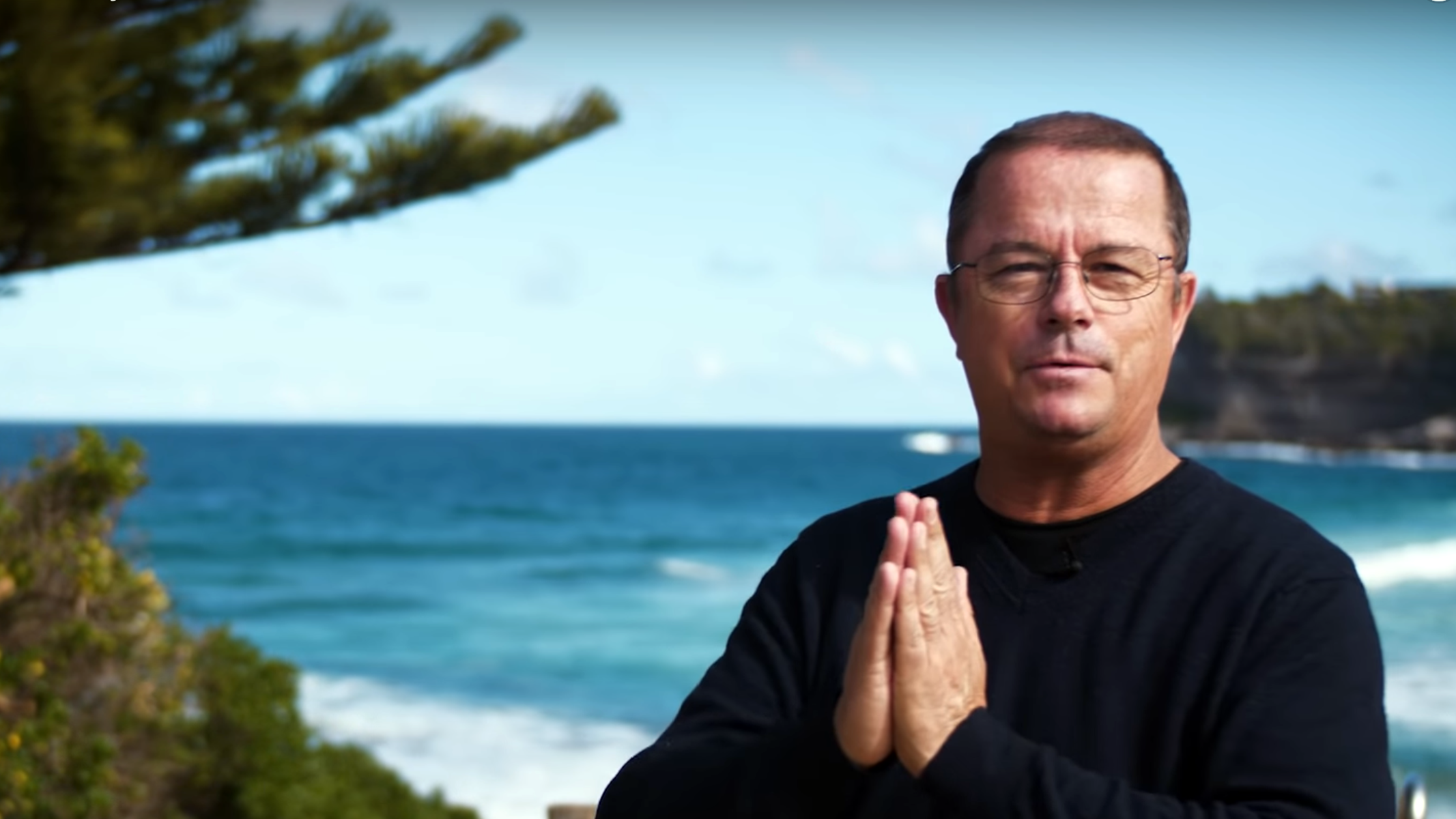
Fifteen years ago surfboard shaper Greg Webber set out on his path to
Soon he was transformed, in the American surf psyche at least, from “that guy who shapes Taj Burrow’s boards” to “wave pool guru.”
But subsequent Webber ideas, most recently his floating reefs, woke us to the fact that Greg Webber isn’t only about wave pools and surfboards. He’s surfing’s mad inventor, exploring any type of wave-riding enhancement. Webber can’t help himself. He can’t stop, won’t stop inventing.
“The reason why I come up with a lot of inventions is purely because I like the feeling I get when the problem is presented and I start wondering how to resolve it,” Webber told us. “I already have the basic physical forces in my head from years of playing with water and surfaces and so I ignore them since they’re in there anyway, and then just seed my mind with the problem and let go. That’s the nice feeling. That’s addictive.”
In Webber’s world, there is more than one way to create or enhance waves. And thanks to him surfers now daydream of circular wave pools, floating reefs and artificial kelp beds to cut down on chop.
We thought it was time to explore the firing neutrons in Webber’s brain and take a closer look at all the human-enhanced surfing experiences he has in store for us and where it all started.
Early Days and Kelly
In the early
Eventually, Kelly focused on a linear version of the circular pool design but kept the hull aspect (like Wavegarden’s early Lagoon system). We don’t know if the King did this in response to patent issues, or if it was simply due to discovering the more-suitable-for-linear wave pool Lemoore location.
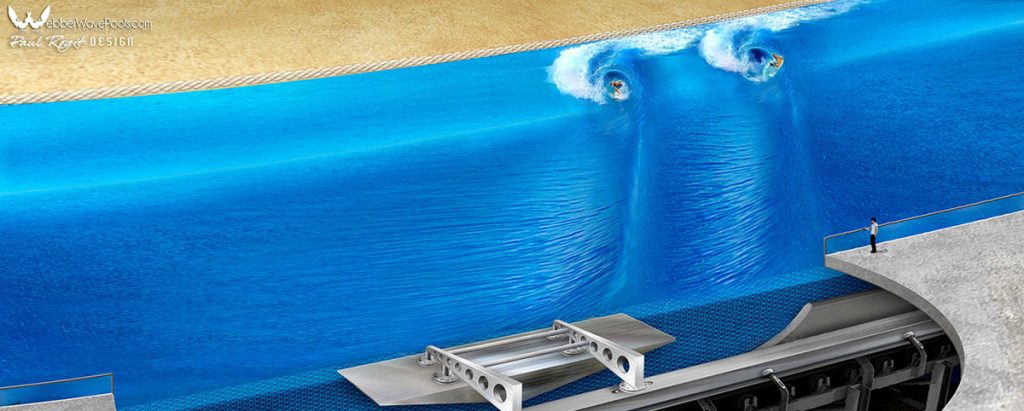
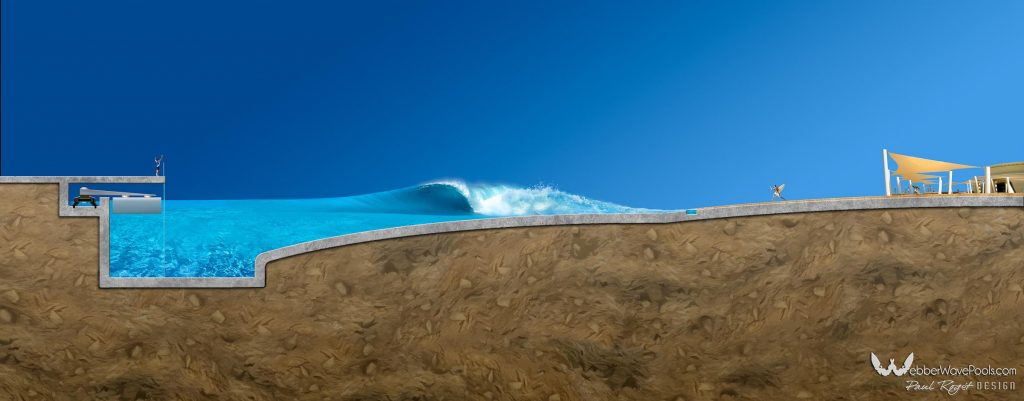
Current Pool System
Webber’s looped linear wave pool system uses “responsive hull design.” This type of foil departs from the traditional locomotive-driven foil of Kelly’s Wave. Instead of just driving straight down a track, the tech uses individual foils called “roller bogies.”
“Each roller bogie can work in unison or independently by track zone,” said Ocean Sports Development, holders of Webber license in the USA. “Unlike inferior systems, the Webber system generates waves traveling in either direction in each zone of the pool. Hydraulic ‘Tilt, Trim, and Yaw’ change the attack angles of the foil to provide any number of wave heights, wave speeds
Motors drive the wheeled carriages along a looped steel rail track kitted out with nitrogen-filled tires (to eliminate noise). So think of it as several smaller, rotating and adjustable wave foils working in unison across a large pool.
“Software controls the speed, the draft, and the angle of each hull,” added Ocean Sports Development. “Control software can be programmed to produce small changes in these three elements, resulting in immediate changes to the wave size and shape.”
On top of this, Webber has added a counter-current to the system to make the waves hollower and better for surfing.
Where are the Webber Wave Pools?
But task any non-surfer with naming a wave pool and they will list Kelly’s wave in Lemoore. It is the most famous surfing wave pool in the world. Why then, if Webber had a head start on Slater by a few years, haven’t we seen a full-scale Webber wave pool?
Webber confirmed to Tracks mag in 2017 that he was just six months shy of testing out his wave pool design at scale. Nothing yet. And this June he told Beach Grit that his Gold Coast wave pool project was now looking for a new location after the original site was re-zoned to make way for a highway bypass.
Faring better are Webber’s American projects. He confirmed in the same article that his US wave pool is already financed and design work has commenced.
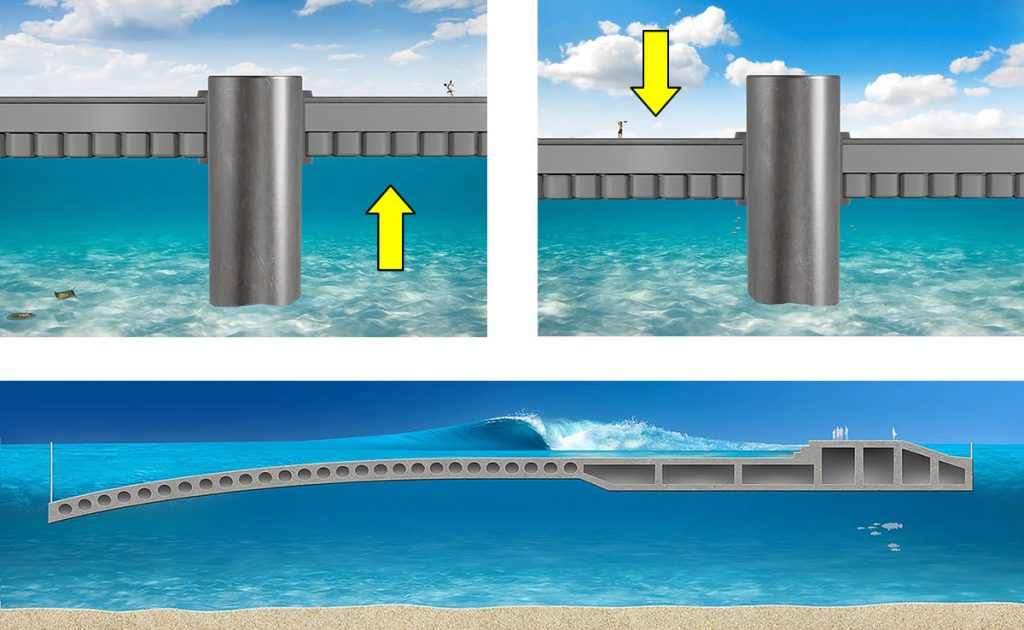
The Introduction of Webber Reefs
Webber’s latest invention to accommodate the crush of surfers worldwide are floating reefs. The world has seen artificial reefs deployed with little success. Sometimes it’s an outright failure as in the case of Bournemouth where the council sunk millions to build, then remove a surfing reef. The handful of artificial reefs that do work are often limited to a few days a year only when all the meteorological elements align.
Webber launched two designs recently, the V-Wall which refracts incoming swells to make a wedge wave. And the V-Reef, which creates a long, peeling right and left. The advantage is that these portable systems can be pointed to maximize the best wind and swell directions. In addition, they cost nothing to power.
The V-Wall Wedge Wave Floating Reef
Shaped like a nutcracker, the V-Wall design can collapse into a rectangle shape for easy transportation. Once at the desired location, the structure is expanded. According to Webber the tip, or point of the vee is anchored just beyond the waves.
“It is designed to float with only 25% above the water line,” said Webber. “Then the whole structure can pivot to point perfectly into all swells at all times.”
Webber adds that adjustable versions can be made whereby the forward tip and the internal support arms are strongly hinged to allow for adjustments to be made remotely from shore.
“As swells periods and wave heights change, or just for the hell of it, different reflected cross wave angles can be made to offer a greater range of wedge waves. Further, if the angle at the tip is altered to be greater than 90 degrees then the swells will be reflected at more than 90 degrees and so they will actually be sent back out to sea direction.”
The V-Reef Floating Pointbreak
The V-Reef reef also floats and has a central anchor point (the giant pin you see in the illustrations). It’s like a dock, but adjustable for wind and swell. Waves hit a submerged reef and peel along the V-Reef left and right for hundreds of yards. Because the entire structure floats up and down with the tide, the artificial bottom counter remains at the same depth throughout tidal changes.
“In the same way weather vanes point into the wind, the reef points into the swell, keeping it perfectly aligned for waves to peel along each side,” said Webber.
Realizing that sharks often seek out large, floating objects that resemble dead whales, Webber has designed a double net for the V-Reef.
Webber sees the floating reef designs as an economic boon to any coastal area that wants to create a surf scene. Or extend the surf-able hours in a day.
“By lighting the nets, the surface of the gradient and the dry zones, night surfing will extend the duration of hotel, retail and entertainment activities located nearby,” said Webber. “Although it is obvious that the commercial activities immediately shoreward would gain the greatest value increase, it is also obvious that significant increases in value would still be achieved at some distance from the reef.”
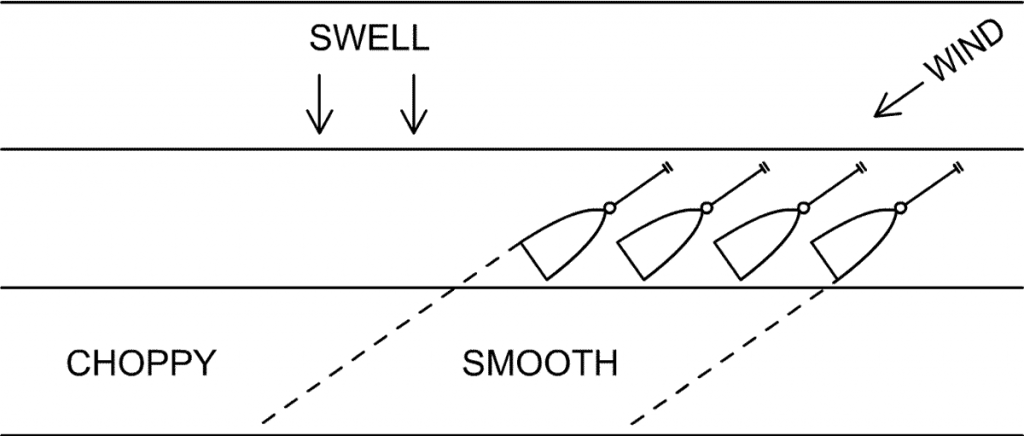
The Chopstopper Surface Sheet
His third idea, the Chop Stopper, works the same as offshore kelp beds. If you’ve surfed an area with kelp beds offshore, like many breaks in Southern California, you’ve noticed the sea surface stays glassy even in wind.
“A buoyant sheet of material is affixed with protuberances of varying lengths on its lower surface to create sufficient drag on the water surface below the sheet material in order to reduce surface waves or “chop” created by wind.”
Webber said there is now an opportunity to invest in Australia and California projects. He said there will be one of the designs deployed shortly in the Chiba prefecture in Honshu, Japan. He did not specify which type of reef or whether it would be a chop stopper.
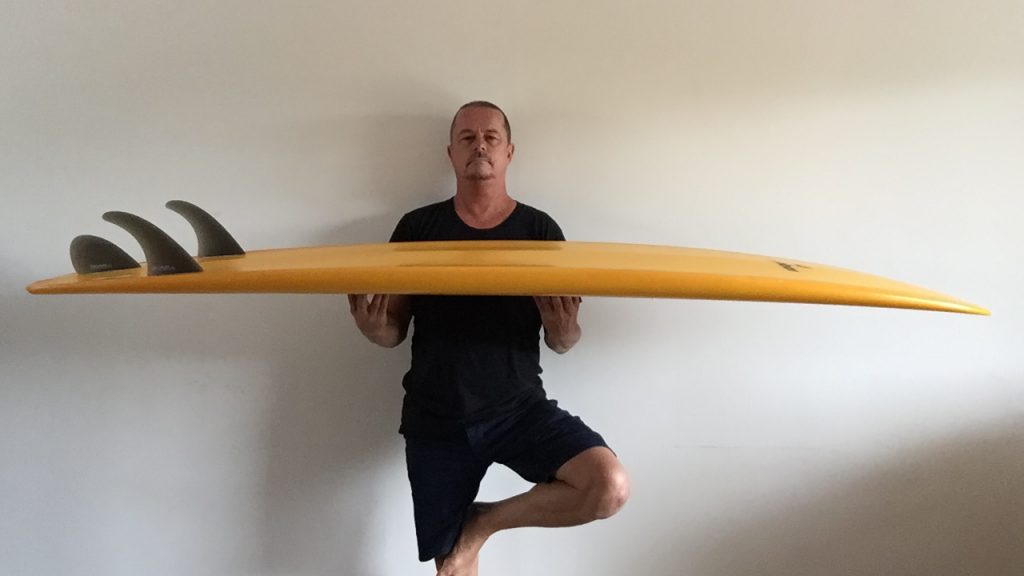
Until then, the only enhanced Webber surfing experience available to us are his surfboard designs. Granted, it’s easier to conceive of and create a surfboard. The whole process takes less than an hour in a full-scale production facility.
It took Wavegarden years and years to develop their tech. And that was with a dedicated team of engineers. American Wave Machines design and tweak in the comfort of their own test tank. Tom Lochtefeld has a nearby government facility to tinker in.
So the big question is why isn’t there a Webber wave pool yet? We don’t know. There are investors out there. There is plenty of interest. And Greg Webber appears to be of solid mind.
We do know that Webber straddles the line between the scientific and the artistic. Perhaps this approach, while well-suited to visual problem solving, falls short in the get-an-investor department.
“I don’t exactly use the same mental methods as to what scientifically minded people might use, nor do I use the approach that highly creative people use,” continued Webber. “The scientist wants to look at the problem and break it down into its key elements. The artistic type wants to create something quickly before they even know what the dynamics are. As a result, I guess I can solve problems quickly and make things that work better than what’s there at the moment.”
And yes Webber’s designs, those beautiful artist renderings that keep alive our curiosity and stoke, frequently offer better solutions than what’s available right now.
Trackback from your site.
Related Coverage

Surf Planner Update: The world’s latest wave pools January 2021
| #
[…] “Hopefully it’ll be worth the wait!” Webber told us. “And yes it’s a single channel linear pool that goes up and back. About a 25-second ride at head high and they are planning on making 2.25-meter waves. About 120 waves an hour with one hull and nearer to 180 with two hulls. The plan is for this smaller non-looped design for the colleges and training and the full scale looped linear for larger-scale developments next to existing hotels. What’s great is that it will still allow for customized waves and they want to use the current control system too.”For more information on Webber’s system check this link. […]